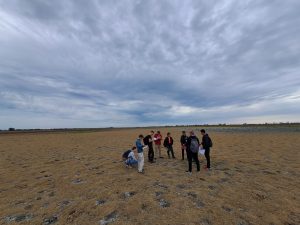This year’s annual hydrogeology field exercise was held between 25 and 28 September in the surrounding of Apaj-Szúnyogpuszta with the participation of three Hungarian and four foreign students. The purpose of this training is to prepare students to solve complex hydrogeological problems and to acquire the necessary practical skills in addition to their theoretical knowledge. During the week-long project in the Kiskunság National Park, they could master their skills in hydrogeological mapping, water sampling, and geophysical measurements. The instructors were Dr Szilvia Szkolnikovics-Simon, Ábel Markó, and Soma Oláh from Department of Physical and Applied Geology as well as Dr Márk Szijártó from Department of Geophysics and Space Sciences. As in previous years, we also welcomed Dr Imre Müller, Honorary Professor of ELTE.
On the first day, students participated in a field survey led by Dr Szilvia Szkolnikovics-Simon and Dr Emil Boros (Centre for Ecological Research) to learn about the hydrogeological background and the unique saline habitats of the area. Based on their experience and preliminary data collection, the students determined the locations of geophysical measurements and drillings necessary to understand the near-surface hydrostratigraphic and geological structure.
On the second day, the field exercise continued with installation of shallow drillings. Water levels in the boreholes were measured and the main physical and chemical parameters of groundwater were determined. The sediment samples taken during the drilling will be analysed in the laboratory of the Department after the field work.
The third and fourth days were dedicated to learning about geophysical instruments used to detect shallow siliciclastic environments. Prof. Imre Müller presented his self-developed electromagnetic measuring device to the international audience.
The research in this area, involving an MSc student, will continue in the framework of the Multidisciplinary National Laboratory for Climate Change project RRF-2.3.1-21-2022-00014.



